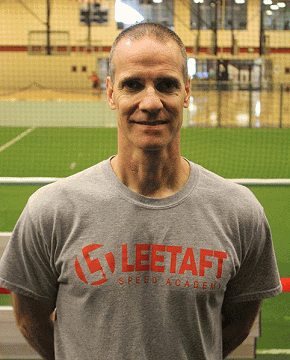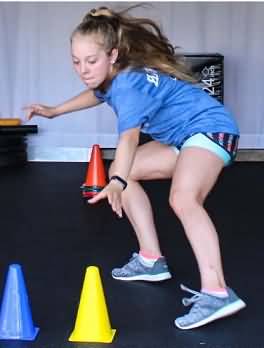Basketball Speed Starts with Stopping
- contributed by Lee Taft
From the Coach’s Clipboard Basketball Playbook"Helping coaches coach better..."
I would like to welcome Lee Taft and thank him for submitting this article. Lee is known as "the Speed Guy", and has devoted his life to helping players of all sports and all levels to improve their speed, mobility, and quickness. We used to think these things were inherent, something a player either had (born with) or didn't have. But Lee has shown that, like most other skills, these things can be taught and improved with proper training.
This article is very interesting... probably something most of us haven't thought about before. - Coach Gels
Lee Taft, known to most simply as "The Speed Guy", is highly respected as an athletic movement specialist. The last 29 years he has devoted the majority of his time training multi-directional speed to all ages and ability levels, teaching his multi-directional speed methods to top performance coaches and fitness professionals worldwide. Lee has also dedicated countless hours mentoring up-and- coming sports performance trainers, many who have gone into the profession and made a big impact themselves.
His innovative approach to training has impacted how many coaches teach athletic movement. Lee brought to light the importance and fine points of the innate quality of repositioning- "Plyo Step", "Hip Turn", "Directional Step" and connection to fight or flight. According to Lee, "Speed and agility done right is about making sure we marry the natural movements athletes have with effective and efficient body control to maximize speed and quickness".
Lee has been a speaker at numerous strength and conditioning and sports performance events across the world and has produced many instructional videos in the area of multi-directional speed and movement training. In addition, Lee has written several eBooks specifically on movement techniques and speed development. Lee and his wife Jennifer have 3 children, Jae, Bailee and Brennen and currently reside in Indiana.

Lee Taft
Isn't it so obvious when you see a player just blow by a defender that there is no mistaking speed and quickness? But the focus may be on the wrong end of speed. Now, don't get me wrong. First step speed and acceleration is king in the sport of basketball. The issue is basketball isn't just a linear sport by any means. There are stops and starts, lateral and angular cuts and deceleration; basketball requires players to have great multi-directional speed.
Some of the fastest players are not the quickest. Let me explain what I mean. There are some players that can accelerate to near top end speeds in only half the courts distance, yet when they need to change direction they are slow. Why is this the case? The issue with this type of basketball player is they have poor body control and techniques when it comes to deceleration. They cannot control all that momentum built up going in one direction then stop it and redirect it into a new direction.
Let's cover some reasons why deceleration is used in the sport of basketball:
- Deceleration can be in the form of stopping, slowing down, or cutting. Stopping and slowing down are the actual intended act of decelerating purposely. Cutting may or may not be a purposeful act of slowing down. It just may be that the cut was at a sharp enough angle that it requires the athlete's momentum to be slowed down somewhat, even though the hoop player is trying to cut aggressively.
- Deceleration is either a tactic or a reaction to a tactic. This means the offensive player wants to make the defender think he is stopping so he can get the defender to slow down, let his guard down and then blow by him with a quick first step acceleration. Now on the other side of the ball, the defender must decelerate as a reaction to the offensive player's move. So you see deceleration isn't always planned.
- Obviously there are many reasons why an offensive and defensive player will decelerate. The key strategies to doing it well are to eliminate any unwanted actions that may lengthen the deceleration more than needed or wanted and use the deceleration in conjunction with the skills of the game of basketball. If you cannot maintain your dribble while cutting (change of direction dribble) or faking, the deceleration does you no good. From a defensive perspective, if decelerating is a weak point in your movement skill, playing good hard defense will be a chore!
- The position of the body in regards to alignment is important. Now keep in mind that most athletes will naturally just react and perform the deceleration skill correctly. The problem comes when there are athletes that do not perform it correctly and subject themselves to potential injuries. Even the athletes that do decelerate quickly may be doing it incorrectly, but it is a natural motor program for them due to hundreds and thousands of repeated repetitions in that pattern. These are the athletes that have a difficult time breaking old habits.
- I am going to start with the lower leg on deceleration. I will use the lateral shuffle or defensive slide as an example. In order for the defender to be able to decelerate and stop quickly when moving to his right, the following things must occur.

- The right leg must be quickly positioned wide enough to stop the momentum of the body, yet not so wide that the player slips. Conversely, if the right foot is positioned too close under the hips the momentum and the weight of the upper body will cause the player to stumble or take several stutter steps to stop.
- Next, the right foot should be pointed straight ahead if not a tiny bit turned in. The ankle must also be dorsi-flexed (cocked ankle) for 2 reasons. The first is because it will close down the ankle joint and take the play out of it. This is important in reducing the rolled or sprained ankle. Secondly, the dorsi-flexed ankle creates a stretch reflex action within the muscle and tendon complex which allows for a more powerful push off if needed. The weight of the athlete should be on the balls of the feet but the heels should not be elevated for the reasons mentioned above. Keeping the foot pointed straight ahead is a more athletic position to move in any direction.
- Moving up the body. The knees need to be inside the width of the plant foot. This allows the force of the momentum to travel straight down the leg, into the foot, and into the ground on the exact angle needed to stop the body. Many people feel the knee should be over the toes when decelerating laterally; this is completely dangerous and non-conducive to greater performance. The knee lined up over the toe vertically when trying to stop horizontal forces is going to potentially cause the ankle to roll, the knee to push out laterally, and the hip to take on more forces than it should. The knee should also be pushed slightly forward helping to create the dorsi-flexed position of the ankle joint.
- To the hips we go! When decelerating laterally one of the things that can cause loss of balance and slowness to recover if re-acceleration is needed, is the extreme lowering of the hips. The hips need to maintain a level height throughout the movement. If they dip too much the athlete is put in a position that will require even more strength just to maintain that stance. Don't over emphasize bending the knees to an extreme. Allow the athletes to be comfortable in their stance and correct the fundamental mistakes that are slowing the movement.
- Finally, let's address the upper body. The shoulders can be stinkers if you are not careful. There is a term that I use and it is called "Swaying". The shoulders, not unlike trees, can have a tendency to sway to the sides, forwards, backwards, or even rotate. When this occurs during deceleration, namely stopping lateral movement, it can drastically reduce the efficiency of the skill; because, in most cases, stopping lateral movement is performed simply to re-accelerate with a change of direction in the opposite direction.
If the player is trying to stop a defensive shuffle to the right and quickly go to the left to stay with the ball handler, and his shoulders are still moving to the right, the quickness of the direction change will be hindered quite a bit. In order for this to not be a factor, the athlete must consciously attempt to be strong with the core region, abdominal, and low back to control movement.
- The right leg must be quickly positioned wide enough to stop the momentum of the body, yet not so wide that the player slips. Conversely, if the right foot is positioned too close under the hips the momentum and the weight of the upper body will cause the player to stumble or take several stutter steps to stop.
Hopefully you can begin to see how much is involved with decelerating. Like I mentioned earlier, this should happen naturally for most basketball players but many will still need some coaching to make the movement more efficient and safer.
What is really important to remember is deceleration, in my opinion, is usually the first step in accelerating in most court and field sports. This means that the athlete needs to know stopping is not the major focus - change of direction is. If the body (feet, legs, hips...) are positioned correctly during the deceleration or stopping action, the re-acceleration process is a continuation of that move. The athlete should be able to start the acceleration out of the same stance used to stop or decelerate. If this is not the case, the athlete is going to always be slower in acceleration and in sport.
I certainly hope this helps to open some eyes as to the importance of deceleration and its impact on court speed and the basketball player!
Train Smart,
Lee Taft